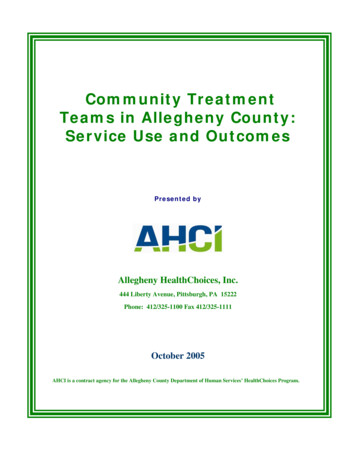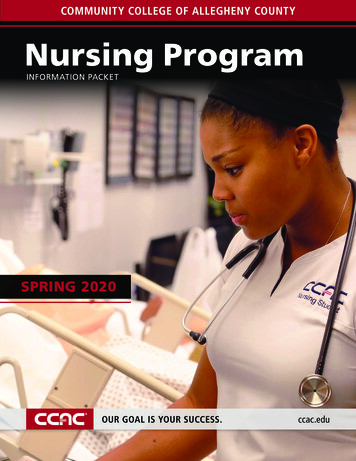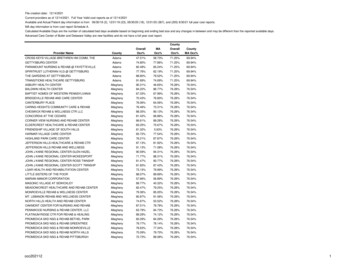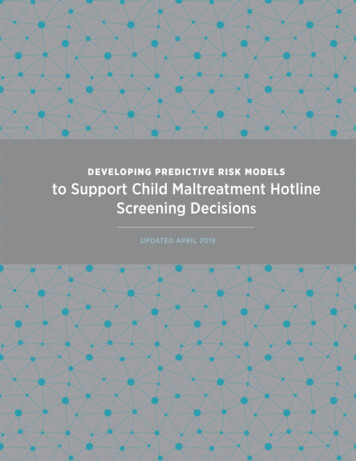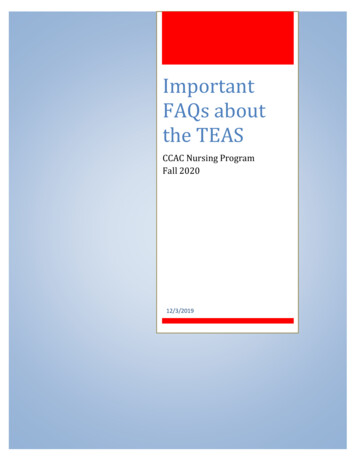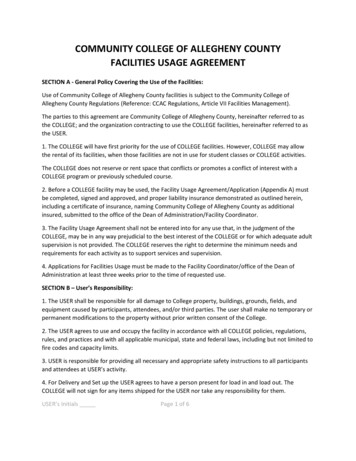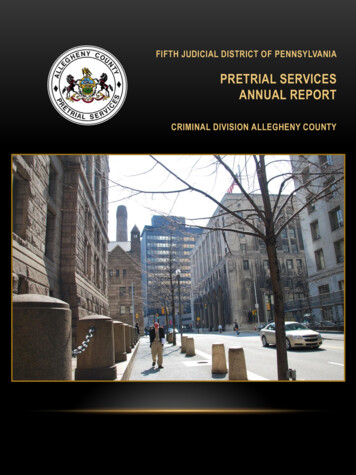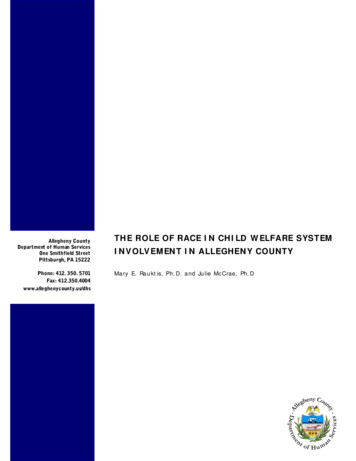
Transcription
Allegheny CountyDepartment of Human ServicesOne Smithfield StreetPittsburgh, PA 15222Phone: 412. 350. 5701Fax: 412.350.4004www.alleghenycounty.us/dhsTHE ROLE OF RACE IN CHILD WELFARE SYSTEMINVOLVEMENT IN ALLEGHENY COUNTYMary E. Raukt is, Ph.D. and Julie McCrae, Ph.D
Allegheny County Department of HumanServicesT he A lle g he ny C o unty D ep ar tm ent of Huma n S er vice s (D HS ) is de dic a te d to mee ting thehum a n se rv ice s ne e ds o f c o unty r es ide nts, pa r tic ula r ly the c o unty 's mo s t v ulner a blep o p ula tions , thro ug h a n ex te ns iv e ra nge of pr eve ntio n, e ar ly inte rv e ntio n, cr ise sm a na g em e nt a nd af ter -ca re s er vice s .T his re p or t wa s p re p are d by the O f fice of D a ta A nalys is , Re se ar c h a nd Ev alua tio n (DA R E),a n of f ic e within D HS . D AR E s upp or ts a nd p ub lis he s re se ar c h re la te d to the a c tiv itie s o fD HS o f fice s includ ing : A g ing ; B e hav ior a l Hea lth; C hild re n, Y outh and Fa m ilies ;C o m munity Ser v ic es a nd I nte lle c tua l D isa b ility.D HS r es ea rc h p ro d uc ts a re a va ila b le fo r vie wing a nd d o wnloa d a t the D HS R es ea rc h a ndEv alua tio n we b pa ge a t www.a lle g he ny c ounty .us /dhs /r es ea rc h.a s px . C o py r ig ht 2010 A lle g he ny C o unty D HSP ub lis he d 2010 by A lle g he ny C o unty D HSA lle g he ny C o untyD e pa r tm e nt o f Huma n S er vice sO ne S mithf ie ld S tr ee tP itts b ur g h, PA 15222P ho ne : 412. 350. 5701Fa x : 412.350.4004
F ig ure s an d Ta ble s . .1Gl os sary . . 2ContentsCo n tr ib u to rs . . 3Ex ec utiv e S um m ary . . 4O ve rv ie w . . 4S tud y Me tho d . . 4Find ings . 4C o nclus io ns and R ec o mm e nd a tio ns .5B ac k gr ound . 6W hy d o C hild re n Ente r the C hild We lf ar e Sy s te m ? . 6Me tho do lo gy . . 10Q ua ntita tive S tudy D es ig n . 10Q ua lita tiv e S tudy De s ign 12D a ta Ana ly sis . 14D es cr ip tio n o f the S am p le and D is p ro p or tiona lityR a tes a nd I ndice s . 14D o R ef er ra l a nd R is k As se ss me nt C ha ra c te ris tic s V aryA c co rd ing to a C hild’s R ac e? 17W ha t C har ac te ris tic s P re d ic t I nve s tig a tio n a ndS er v ice s ? 21S y nthe sis o f Q ua lita tive a nd Q uantita tiv e Find ing s .27C o nclus io ns and R ec o mm e nd a tio ns . 34D isp ar ity in C Y F R ef er ra ls . 34C o m munity Fac to rs a nd Re f er ra l D is pr o po r tio nality . 35A d dr es s ing S ys te m Bia s . 37C o nclus io ns and R ec o mm e nd a tio ns . 41R e so ur ce s . 43C o ntac t I nfo r ma tion . 43B ib lio gr a phy /Fur the r R ea d ing . 43A p pe nd ix A P o pula tio n a nd Sa m pling Fr am e . 46A p pe nd ix B R eq ues t fo r Eva lua tio n . 47A p pe nd ix C Mod e l R is k As se ss me nt For m 48
FIGURESFig ure 1: C Y F Re f er ra ls by R ac e Figures and Tables14Fig ure 2: Pr o po r tio n o f A fr ica n-A me r ic an C hildr e n Re fe rr ed ,I nve s tig a te d a nd Se rv ed in 2006 . 15Fig ure 3: Pr o po r tio n o f White C hild re n Re f er re d,I nve s tig a te d a nd Se rv ed in 2006 .16Fig ure 4: Pr o po r tio n o f B ir ac ial C hildr e n Re fe rr ed ,I nve s tig a te d a nd Se rv ed in 2006 . 16Fig ure 5: A ge o f C hild re n a t C Y F Re fe rr al A c co rd ingto C hild R ac e /Ethnicity .18Fig ure 6: S ig nifica nt Dif fe re nc es in Re fe rr a lC har ac te ris tic s b y C hild R ac e .19Fig ure 7: T ar ge ting Re fe rr a l D is pr o po r tio na lity in A lle ghe nyC o unty (Le mo n, A ndr ad e & A us tin, 2005) 35TABLEST a b le A : D is p ro po r tio nality I nd ex . 17T a b le B : P ro po r tio n o f C hildre n with Mo de ra te or Hig h Ra tingso n Risk A s se ss me nt D o ma ins by C hild Ra ce . 20T a b le C : P ro p or tion of C hildr en Inve s tig a te d a nd Se rv ed A c co rd ingto C ha ra c te r is tics o f the R ef er ra l a nd Re s ults of B iv ar ia te A nalys es 22T a b le D : R es ults of B iva ria te A na lys es of the Pr op or tio n o f C hildr e nO p e ne d f or S erv ice s Ac c or d ing to R isk As se ss me nt Ra tings o n Ea c hI nd iv id ua l I te m a nd Ov er a ll S ev er ity and R isk .23T a b le E: Re sults o f Lo gis tic Re gr es s io n A nalys es P re d ic tingC a se I nv es tiga tio n 24T a b le F: C um ula tive Risk a t the T im e o f I nve s tiga tionb y C hild Ra ce /Ethnic ity 26T a b le G : R es ults of Log is tic R eg re s sio n A na ly se s P re dic tingC Y F S er v ic es . 261
GlossaryD HSD e pa r tm e nt o f Huma n S er vice sC hild LineP e nns ylva nia C hild Line a nd A b use R eg is tr yC 2P 2C ultura lly C o mp e te nt P ro f es sio na l P ra c tic e Pr o je c tCPSC hild Pr o te c tiv e Se rv icesCYFO f f ic e o f C hildr e n, Yo uth a nd Fa m iliesFG D MFa m ily G ro up D ec is io n Mak ingG PSG e ne ra l P ro tec tive Se rv ice sI RBI ns titutio nal Rev iew Bo ar dT A NFT e m po ra ry A ss is ta nce f or Nee dy Fa m iliesW P ICW e s te r n P syc hia tr ic Ins titute and C linic2
T he A lle g he ny C o unty D ep ar tm ent of Huma n S er vice s (D HS ) a nd the Univer s ity ofP itts b ur g h’s S c ho ol of S oc ia l W ork C hild W e lf ar e Ed uc a tio n a nd Re se ar c h Pr o gr am sContributorsj o ine d to ge ther to s up p or t this pr oj ec t. P ro je c t pa r tner s g ra c io usly p ro vid ed da ta ,a na ly sis , p ro gr a mm a tic a nd o the r s up po r t to the initia tive . C r itic al fund ing fo r thisp r oj ec t was pr ov id e d by the Unive r sity o f P itts b urg h C e nte r o n Ra ce and S oc ialP r ob le m s .T he f o llo wing ind iv id ua ls co ntr ib uted the ir time , k no wle dg e a nd tale nt f or thec o m ple tio n o f this re p or t: Mic hae l C unning ham , M.S . – Unive r sity o f P itts b urg h S c ho ol of Pub licHe a lth G ar y Ma rs h, P h.D . – Unive r sity o f P itts b urg h S c ho ol of P ub lic He a lth C y nthia B ra d ley -K ing , P h.D . – Unive r sity o f P itts b urg h S c ho ol of S o cia lW o rk T a m my T hom as , M.S .W ., M.P.H. – Univer s ity of P itts b ur g h Sc hoo l o fP ub lic He a lth D e bb ie S wer d lo w, M.S .W . – Unive rs ity o f P itts b ur g h S cho ol of S oc ialW o rkW e wo uld a ls o lik e to tha nk Erin D alto n, Lisa C a ld we ll, D r . Mar c ia S turd iva nt a nda ll o f the C hild re n, Y o uth a nd Fam ily (C Y F) a dm inis tr a to rs in the f iv e Alleg henyC o unty of f ic es f o r their a ss is ta nce in r ev ie wing this re p or t a nd o b ta ining da ta .3
OVERVIEWT his s tudy a ime d to do c um e nt the se rv ice p a ths of A f rica n-A m er ic a n a nd whiteExecutiveSummaryc hildr en fo llo wing re fe rr a l to A lle g he ny C o unty c hild welf are se rv ic es , a nd toid e ntif y loc a l de c is ion-ma k ing po ints , c as e c ha ra c ter is tics , o r ga niz a tio n a ndc o m munity fa c tor s tha t m ay c o ntr ib ute to se rv ic e d isp ar itie s . T he s tud y q ue s tio nswe re : W ha t is the e x te nt of r ac ial d is pr o po r tio nality a t re f er ra l, inv es tiga tio na nd s er vice pr ov isio n? O ther thing s b e ing e q ua l, is a c hild ’s ra ce r e la ted to the lik e lihoo d tha the o r s he will be inve s tig a ted a nd a cc ep te d f or s er vice ? W ha t do c hild welf are pr o fe ss io na ls id e ntif y as the ca us es fo rd is pr o po r tio na lity?STUDY METHODT he s tudy took p la ce be twe e n Januar y a nd Nov em be r 2008 a nd use d a m ixe dm e thod s d es ig n. Ad m inis tra tiv e a nd f ie ld da ta o n a s tra tif ie d r and om sa m ple o f460 c hildr e n, ag es 0 to 17, we re us e d in the b ivar ia te a nd m ultiv ar ia te a nalys es .T he s am p le inc lud es c hildr e n who had a t le as t o ne r ef er ra l to the D HS O f fice ofC hildr en, Yo uth a nd Fa milie s (C Y F) be twee n Ja nua ry 1, 2006 a nd D ec e mb er 31,2006. Qua lita tiv e interv ie ws we re a lso c o nduc te d with 11 C Y F c as e wo rk er s,s up erv iso rs and r eg io na l d ire c to rs a b o ut the ir p er ce p tions o f ho w they o b ta ininf or m a tio n to m ak e d ec isio ns a nd the r ole tha t r ac e p la ys in their d ec is io ns .FINDINGSR e fe rr als a nd inv es tiga tio ns a t C Y F in 2006 s ho w the m os t no ta ble d isp ar ityc o ncer ning the ra te a t whic h A fr ic a n-A me rica n a nd b ira cia l c hild re n ar e re f er re d toC Y F. A fr ica n-A me r ic a n c hild re n ar e re fe rr e d a t thre e tim es the r a te of whitec hildr en, with little e v id e nc e to s ugg es t tha t the ir lev e l of risk o r nee d f or se rv ic esis sub s ta ntially d if fe re nt tha n tha t of white c hild re n. T his is ev ide nc e d by nos ig nif ica nt dif fe re nc e in o ve ra ll r is k ra tings a t re fe rr al an d inve s tig a tio n be twee nA f rica n-A m er ic a n a nd white fa m ilie s a nd f ew sig nif ica nt dif fe re nce s in ra tings ofp a r tic ula r ty pe s o f risk s , s uc h a s c ar eg iver s ub s ta nce a b use a n d a mo unt o f f am ilys up po r t. T he only s ig nifica nt c ha ra c te ris tic s o f A fr ic a n-A me rica n fa m ilies a cc or d ingto thes e d a ta a re mo re f re q ue nt co ntac t with C Y F, re fe rr als invo lv ing m ore c hildr e na nd s lightly hig her ra tes o f c hild re n ha ving r ec eive d p ub lic a ss is ta nce .4
B ira c ia l c hild re n a re r ef er re d a t f o ur time s the ra te c om pa re d with white c hildr en,ExecutiveSummarya nd ha d s ig nif ic ant d if fe re nce in risk ra tings a t re fe rr al in ter m s of ca re g ive rc a pa c ity (p hys ic a l, em o tio nal and inte llec tua l) a nd pa re nting sk ills a nd kno wle d ge .Multiv ar ia te a na lys es f o und tha t c hild r ac e s ig nifica ntly pr e dic ted ca seinve s tiga tion, with Af r ic an-Am er ica n c hild re n le ss like ly to be inv es tiga ted thanwhite c hild re n. B ir ac ia l c hildr e n wer e twice a s lik e ly to be the s ub je c t o f aninve s tiga tion co m pa re d with white c hild re n.T her e was no ev ide nc e in the se d a ta of a f unne ling e ff ec t fo r A fr ic a n-A me rica nc hildr en, whe re d is pr op or tio na lity inc rea se s a t e ac h de cis io n po int (Va nde rg r if t,2006). R a the r, d is pr o po r tio nality in A lle g he ny C o unty f o r Af r ic an-Am er ica nc hildr en, who r e pre se nte d 68 p er ce nt of c hildre n in fo s ter c ar e in 2008(P e nnsy lva nia P ar tner s hip s f or C hild re n, 2009), a pp ea rs r e la ted to d is p ar a te r a te so f r ef er ra ls a nd mo re fre q ue nt re -r ef er ra ls tha t invo lv e m or e c hildr e n co m pa re dwith o the r f am ilie s.CONCLUSIONS AND RECOMMENDATIONSW hile the ind iv id ua ls inter v ie we d f or this s tud y (ca se wor ke rs , s upe rv is or s a ndd ire c tor s ) ac k no wle d ge d tha t A fr ica n-A me r ic a ns a re dis pr op or tio na te ly invo lv ed inc hild p ro tec tive s er vice s , they id e ntif ie d s ys tem b ia s as a ma jo r c ause and fe lt tha tthe ir de c is io ns we re b a se d o n sa f e ty a nd no t r ac e. The inter vie we es ind ica ted tha tc irc um s ta nce s tha t ar e o f te n e xp er ie nce d b y Af r ic a n-A me rica n fa milie s , s uc h a sha ving a lo w inc om e, liv ing in a n unsa fe ne ig hb or hoo d , s ing le pa re nting , la ck ing ane d uca tion or us ing s ub s ta nce s o r hav ing a se rio us me ntal illnes s wer e lik ely f ac tor stha t ma ke the se fa m ilie s m or e v ulner a ble , inc re as ing the ir v is ib ility to s ys te mss uc h a s c hild we lf ar e . All o f the inter v ie we es fe lt tha t be ing po or and b lac k wer e sointe r twine d tha t it wa s im po s sib le to unr av e l them in or de r to de ter m ine which o nec a us e d Af r ic a n-Am er ica n f a milie s to be d isp r op or tio na tely inv o lv ed in the c hildwe lfa re s ys te m.R e co mm e nd a tio ns ar e to fo c us inter ve ntions o n p o ints in the sy s te m wher ed is pa r ities se em to oc c ur . I nterv e ntio ns s ho uld dr a w f ro m m ultiple ex p la na to rythe or ies fo r re fe rr a l d is pr o po r tio nality. Ba se d o n the th eo ry sug ge s te d by the sed a ta tha t p ov er ty , sy s te m b ias a nd c om m unity f ac to rs r es ults in r ef er ra lFiguresd is pr o po r tio na lity, A lle g he ny C o unty co uld utiliz e ev ide nc e -b a se d a nd e v id e nc es up po r te d pr ac tice s tha t f oc us o n re d ucing d isp ar itie s a t the fr o nt e nd of the c hildwe lfa re s ys te m pa thway .5
WHY DO CHILDREN ENTER THE CHILD WELFARE SYSTEM?BackgroundC hildr en and y o uth e nte r a nd e x it c hild we lf ar e s erv ice s thro ug h a we ll-d ef ine dp a th with m ultip le de c is io n po ints. B ar th (2005) wr ites tha t fo r c hild re n in thec o m munity , e ntry into the c hild welf are sy s te m b eg ins with a r ep or t ofm a ltrea tm e nt. A de c is ion is ma de by s o me o ne in the c o mm unity tha t a c hild isb e ing ab use d o r neg le c ted (o r is a t r isk f or ab use a nd neg lec t) a nd they ma ke ar e fe rra l to c hild p ro te c tive s er v ic es . I n A lle ghe ny C o unty , re f er ra ls ca n c om ethr o ugh the s ta te ’s “C hild Line ” (C PS ), whic h ar e pr ima r ily re f er ra ls fo r a buse , o rthr o ugh Ge ne ra l P ro tec tive S erv ice s (GP S), whic h a re p r im ar ily r ef er ra ls f orne g le c t. T he ne x t s te p is tha t the re fe rr al is either inve s tig a ted o r a d ec is io n ism a de to no t inv es tig a te . Fo r C PS r ef er ra ls, de cis io ns ar e m ad e a bo ut whe the r them a ltrea tm e nt oc c ur re d (“s ubs ta ntia ted ”) a nd whe ther to p ro vid e se rv ic es(“a cc ep te d ”). For G PS r ef er ra ls, there is no pr oc es s o f s ubs ta ntia tion, o nly ad e c is io n a b o ut whe ther to p ro vide se rv ic es . S er vice s m ay b e p ro vid ed to f am ilie swhile the c hild r em a ins a t ho m e, or the c hild ma y be p la ce d in o ut-of -hom e ca re ,s uc h a s in f os ter ca re o r kins hip fo s te r ca re (plac e d with re la tive s ). Go a ls f orc hildr en p la ce d into o ut-o f -ho me ca re ty p ic ally inc lude : r eunif ic a tio n with the irf a m ily , ad o p tio n o r a no ther lo ng -te rm pe rm a ne nt living s itua tio n s uc h a s leg a lg ua rd ians hip (B ar th, 2005).Referent BiasD es p ite re se ar ch s up p or ting tha t c hild m a ltr ea tm ent is unr e la ted to ra ce o re thnicity (Se d la k & S c hulz , 2001a ; S ed lak & Sc hulz , 2005), A fr ic a n -A me rica nf a m ilies a re o ve r -re p re se nted in their re f er ra l to c hild pr o te c tiv e se rv ice s (Fluk e ,Y ua n, He dd er so n & C ur tis , 2003; Lem o n, And ra de & A us tin, 2005). T his pa tter nha s b ee n c alled “r ef er e nt b ia s .” Re se ar c h s ugg es ts tha t the re is a n a ss o cia tio nb e twee n r ef er ra l, ty pe o f re fe rr ing a ge ncy a nd c hild a nd fa m ily r ac e . Me dica lp e rs o nne l ar e m or e lik ely to r ep or t Af r ic an-Am er ica n c hild re n to c hild we lf ar es e rv ic es c o mp ar e d with o ther c hild re n (A rd s & Har re l, 1993; Ha mp to n &Ne wb er ge r , 1988; Hine s e t a l., 2002), whe re as sc hoo ls ar e mo re like ly to re f erLa tino /His pa nic fa m ilies (Hine s e t a l., 2002). A s tudy of e m er ge ncy r oo mp hy sic ia ns fo und tha t A fr ica n-A me r ic an pa re nts wer e m or e lik ely to be r ep or te d fo ra b use , ev e n af ter co ntro lling f or the lik eliho o d o f ab us ive inj ury (La ne , R ub in,Mo nte ith, & C hr is tian, 2002). A ltho ug h b o th white and A fr ica n-A me r ic a n wom e nus e d r ug s d uring p re g na ncy a t sim ila r ra tes , A fr ica n -A me r ic a n wom e n wer er e po r te d f or child m altre a tme nt up o n d eliv er y a t a p pr ox ima tely 10 tim es the ra tef o r white wom e n (C ha sno ff , La ndr es s & B ar re tt, 1990; Ka rp , 2001).Figures6
Decisions to InvestigateO nce a re fe rr al is ma de to c hild pr o te c tive se rv ic es , a k ey d ec is io n is whe the r toBackgroundinve s tiga te. Are Af ric an-Am er ica n f am ilie s inv es tiga te d a t a gre a ter r a te ? T hisq ue s tio n wa s exa m ine d us ing da ta f ro m the Na tio na l I nc ide nce S tudy (NI S -3;S e dlak & Sc hulz , 2001b ; Se d la k & S c hulz , 2005). Af r ic a n-A mer ica n c hild re n whoe x per ie nce d e m o tio na l m a ltr ea tm ent, p hys ica l ne glec t or fa ta l or s er io us inj ur y hadc a re give rs with s ubs ta nc e ab use pr ob lem s , a nd thos e whos e ca se s wer e re p or tedb y p r of es s io na ls wer e m or e lik ely to b e inve s tig a te d tha n white c hild re n with thes a me c har ac ter is tic s . An ana ly sis o f the 2000 NC A ND S d a ta fr om fi ve s ta tesr ev ea le d tha t A f rica n-Am er ic a ns we re twic e a s lik ely to b e inve s tig a te d a s white s(Fluke , Yua n, Hed d er so n & C ur tis , 2003).Mo s t une q uiv oc al a re find ing s tha t A fr ica n-A me r ic a n c hild re n ar e ov er re p re se nte da m o ng childr en in f os ter c ar e . Ev er y s ta te in 2000 s ho wed dis pr o po r tio na te r a te so f A fr ica n-A me r ic a n c hild re n e nte r ing f o s te r ca re , with ra tes tha t ra nge f ro m 1.5 8to ov er 65 time s the r a te o f white c hild re n (Va nde rg r if t, 2006). V and er gr if t r ef er sto a “f unne ling e ff ec t,” mea ning tha t the p er ce ntag e o f m ino r ity r ep re se nta tio ninc re as es a t eve ry s te p o f c hild we lf ar e inv o lv em e nt. T he o nly s ta ge whe re the rea re no ra cia l d iff er ence s is in r a te s o f c hild re n’s r ee ntry into the c hild we lfa res y s te m (Hill, 2006).T her e ar e the or ie s as to why Af r ic a n-Am er ica ns a nd o ther m inor ities a re r ef er re da nd inve s tig a te d a t gr ea ter r a te s tha n white f am ilie s. One theo ry a t the re fe rr a ls ta ge is tha t indiv id uals hav e b ia se s a nd inc o ns is te nc ie s in the ir de cis io n-mak ingp r oc es se s tha t r es ult in a gr ea ter num b er o f re f er ra ls of A fr ica n-A me r ic a ns to c hildwe lfa re s er v ic es . C alled “r ep o r ting b ias ” (Dr ak e & Z ura vin, 1998), it wa se m p ir ic a lly e s ta b lis he d in 1980 in the Na tiona l I nc ide nc e S tudy NI S -1 (A r ds &Ha r re ll, 1993), whic h f o und tha t fa m ilies with s us pe c te d ma ltr ea tm ent a nd hig herf a m ily inco me ha d a le ss er c hance of ha ving a f or m al re po r t m ad e . Ho we ve r , thisf ind ing wa s no t s up po r te d whe n the NIS Wa ve 1 d a ta we re r e -a na lyz ed , due top o ss ib le s e le c tio n b ias in the fir s t a na ly s is (A rd s , C hung , My er s , 1998). Z e llm an(1992) us ed v ig ne ttes to s ur ve y 1,196 ma nda te d re po r ter s a nd fo und so m ee v id e nc e of “la be ling b ia s ” or the tend ency to loo k fo r a nd f ind ma ltrea tm e nta m o ng cer ta in g ro ups . Ho wev er , this f inding has no t be e n re p lic a te d in o thers tud ie s a nd in the la s t 20 y ea rs , no s tud ie s have s up p or ted the pr es e nc e ofla be ling b ia s in c hild pr o te c tiv e se rv ice s (D ra ke & Z ur av in, 1998).Figures7
Case ManagementI f la be ling is n’t the r ea so n f or why c hildr en e nter the child we lf ar e sy s te m , it ma yBackgroundb e pre d ic tive o f wher e c hild re n e nd up in the s er v ic e pa thway . I n a n ea r ly s tudy ofho w ca se m a na ge rs ma ke d ec is io ns ab o ut c hild re n in s ta te c us to dy , Ma r tin, Pe te r sa nd G lis so n (1998) f o und tha t ca se ma na g er s’ p la ce me nt a nd se rv icer e co mm e nd a tio ns wer e g uid e d le s s by s tr uc tur ed a s se ss me nts a nd mo re on thela be ls g iv e n to c hild re n a nd ho w they e nter ed into s ta te ca re . R es ea rc h o nd e c is io n-ma king in c hild welf are s ug ge s ts tha t c as e wo rke r s la ck the pr er eq uisitec o m pe tenc ie s nee de d f or e f fe c tive as se ss me nts , ther eb y re lying o n the ir o wnb e lie fs a nd c ultur e in m ak ing as se ss m ents (R yc as & Hug he s , 2003). T he r es ea rc he m er g ing f ro m the be ha v io ra l d ec isio n m ak ing fie ld fr om o ther pr o fe ss io ns s uch a sm e d ic ine , la w, nurs ing and o c cup a tio na l the ra py a d d to o ur unde rs ta nding o f ho wm a nda te d re po r te r s and o ther s use co g nitive s hor tc uts or he uris tic s to ma ked e c is io ns to r ep o r t or no t re po r t, to inve s tig a te or mov e to s ub s ta ntia tio n a nd ifthe se de c is io ns a re c re a ting d is pr op or tio na lity . Fina lly , the use o f c o ns e ns us-b as edr a the r tha n a c tua ria l risk as se ss me nts in mak ing d ec isio ns may be c o ntrib uting tod is pr o po r tio na lity by ina cc ura tely c la ss ify ing ca se s to r isk lev els (Ba ird & R yc us,2005; Eng lish, A ub in, Fine & Pe co ra , 1993).PovertyA no the r theo ry is tha t d is pr o po r tio nality has le ss to do with the ra ce of ther e side nts a nd m or e to d o with the disa d va nta g ed char ac te ris tic s o f f am ilie s a nde c ono mic d e pr iv a tio n o f the c om m unities in whic h the y liv e . T he re is a linkb e twee n p ov er ty a nd the like liho o d o f c hild a b us e (S e dlak a nd B ro ad hurs t, 1996).Ne ig hbo r ho od po ve r ty is po sitive ly a s so cia ted with ma ltre a tme nt a nd, in p ar ticular ,with c hild ne glec t (D ra ke & Pa nde y , 1996). For e xa m ple , Ko r bin e t al. (1998), in as tud y o f b la ck a nd white neig hbo rho od s in C uya ho g a C o unty, fo und tha tm a ltrea tm e nt ra tes were lo wer fo r Af r ic a n-Am er ica n f a milie s , a nd co nclude d tha tc hild m altre a tme nt wa s d e te rm ine d m or e b y p ove r ty than ra ce . T he co m bina tio n o fim p ov er is hed ne ig hb or hoo d s with hig h c rim e, a c ce ss to ille ga l s ubs ta nc es a ndlim ited a c ce ss to jo b s, so c ia l se rv ice s, and s af e a nd af f or da b le ho using m ay cre a tehig h lev e ls o f nee d tha t re sult in c hildr e n be ing re fe r re d to c hild pr o te c tiv es e rv ic es (D e ttla ff & Ry c ra f t, 2008; Ga rb ar ino & Ec ke nr o de , 1997).Figures8
Child Welfare Organizational ClimateFina lly , the c lima te of child we lf ar e or g aniza tio ns is tho ug ht to c o ntr ib ute toBackgroundd is pr o po r tio na lity. Or ga niza tio na l c lim a te s tud ie s s ugg es t tha t p os itiv ee nviro nme nts c har ac ter ize d by lo w co nflic t p er so naliza tio n a nd co lla bo ra tio n ar ep r ed ic tive of po s itive ser v ic e o utc o me s as we ll a s q ua lity (G lis s on & He m me lga rn,1998; G liss o n, 2009). Y e t f e w wo uld c har ac ter ize the c urr e nt c lim a te o f p ub licc hild we lf ar e ag e nc ie s a s p os itiv e . C hild we lf ar e or g a niza tio na l c lim a te s a re o f tenc har ac te rize d b y f ea r of lia b ility or p unitive c o ns eq uence s (De ttlaf f & Ry cr af t, 2008p . 53). In a se r ie s of fo c us gr o up s with dif fe re nt s tak eho lder s f oc us ing o n ther ea s ons f or dis pr o po r tio na lity , D e ttla f f a nd R yc ra f t (2008) s umm ar ize d tha t ino r de r to p ra c tic e e ff ec tive ly , wo rke rs ne e d to f ee l s upp or te d by the ag e nc y, andim p ro ve me nts m ad e to the inve s tig a tiv e a nd r isk a ss es s me nt pr oc es se s to r ed ucethe like liho o d of ill-info rm ed de c is ions (p . 53).I f na tiona l re se ar c h s up p or ts tha t de cis io n m ak ing in c hild we lfa re is r ela te d tod is pr o po r tio na lity, wha t do es A lle g he ny C o unty look like ? Re sea rc h on re fe rr alp a tter ns f or ne g le c t in A lle g he ny C o unty be twee n 1986 a nd 1989 f o und tha ta ltho ug h A fr ica n-A me r ic a n fa m ilies co ns titute d 31 pe rc ent of fa m ilies with c hildr e nund er a g e 18 in P itts b ur g h, they wer e 45 pe rc ent of the re fe rr als to C Y F (Ne lso n,S a und er s & La nd sm a n, 1993). W ha t do the c urr e nt p ro po r tio ns loo k lik e co m pa re dto wha t was ob se rv ed 20 ye ar s a go , a nd wha t ar e the d iff er e nce s a t the v ar io usd e c is io n po ints? B a se d o n the p er sp ec tive o f c hild we lfa re wo rk er s, wha t fa c tor sm a y ac co unt fo r why d if fe re nce s ex is t a nd wha t a re po ss ib le s o lutio ns , ifd is pr o po r tio na lity ex is ts ? T he ob je c tiv es fo r the c ur re nt inve s tig a tio n a re toe xa m ine the e x te nt o f r ac ia l dis pr op or tio na lity a nd the d e gr ee to whic h r ac e isr e la ted to lik e lihoo d o f inve s tig a tio n a nd se rv ice p ro v is io n. A s ec o nd ob je c tiv e is toe x plor e the p er ce p tio ns o f thos e wor k ing with fa m ilies a b o ut the ex te nt o f a ndr ea s ons f or dis pr o po r tio na lity .9
T his s tudy us ed a m ixe d me tho d s a pp ro ac h co nsis ting of : (1) a nalys is o f da ta o n ar a ndo m s am p le o f 460 c hildr en re fe rre d to C Y F in 2006; (2) in-de p th q ualita tiv eMethodologyinte rv ie ws with c hild welfa re a g ency ca se wor ker s , s upe rv is or s a nd d ir ec tor s .I ns titutio nal Rev iew Bo ar d (IR B ) ap p ro va l was ob ta ine d f ro m the Univer s ity ofP itts b ur g h IR B .Lim ita tio ns o f this s tud y inc lude inc o mp le te f ield (c as e re co r d) da ta o n 84 ca se s:the re wa s no way to a sc er tain if the se ca se s wer e d if f ere nt fr om ca se s tha t we rec o m ple te . S eve ra l o f the f ield d a ta me as ure s , pa r tic ula r ly r a ting s o f r is k a ndm a ltrea tm e nt ty pe s re po r ted , we re b ias ed in o ne o r a no ther c a teg or y. Fore xa m ple , ther e wer e high numb er s o f “eva lua tio n re q ue s t” lis te d a s the re as o n f orr e fe rra l. A d minis tr a tive da ta d o no t hav e the sa m e le ve l o f p re c is io n a s d a tac o lle c te d f or r es ea rc h p ur po se s . T he re fo re r a ndo m or sy s te ma tic m ea s ure m ente rr or co uld imp a c t the f ind ings . A lso , while the find ing s o n b ira cia l c hild re n ar eno ta b le , they a re ba se d o n a r ela tiv ely s ma ll numb er of c hildre n.QUANTITATIVE STUDY DESIGNA ra ndo m s am p le o f c hild re n wa s se lec te d fr o m the p op ula tio n o f c hildr e n re fe rr e dto C Y F in 2006. Be c ause the fa m ily is the unit o f a na lys is fo r C Y F, a nd c hildr e n ar ene s te d within s ib -s hips , a ll of the c hildr e n in the f am ily re fe rr ed a s we ll as theta r ge t child wer e include d in the po p ula tion num b er o f 19,963. Yo uth o lde r tha n18, thos e with d up lic a te r e po r ts , tho se who se r e po r t was no t in Pe nnsy lv a nia a ndtho s e who were no t the tar g e t c hild o f the r ep or t were then e limina te d , re s ulting ina pr e lim ina ry s am p ling fr am e o f 7,846 c hildr e n a nd y o uth, ag es 0 to 17.I n o r de r to o b tain a r e pr es enta tiv e sa m p le o f the p o pula tio n, a s tra tif ie d sa m p lingd e s ig n wa s c ho se n. S tra ta wer e d ef ine d b y the g end er , r ac e, a g e gr o up a nd ty p e ofr e po r t: C hild P ro tec tive S erv ice s (C P S ) or G e ne ra l P ro tec tive Se rv ice (G PS ).V ar iab les r e la ted to thes e s tra ta wer e m is s ing fo r 354 c hild re n, re s ulting in a f ina ls a mp ling fr a me o f 7,495 uniq ue c hild re n who we re the ta r ge t o f a r ef er ra l in 2006.T he re q uir e d sa m ple s iz e o f 520 wa s the n alloc a te d a cr os s the s tra ta us ingp r o po r tio na l a llo ca tio n, whe re the sa mp le s iz e within a s tra tu m is a ss ig ne dp r o po r tio na l to the s tr a tum s iz e. T he r eq uir e d sa m ple s ize in e ac h s tr a tum wa sr o und e d up to the ne x t hig he s t inte g er o r if the c alc ula ted sa m ple s iz e f or as tr a tum wa s les s tha n two , a s a mp le s iz e of two was us e d, re sulting in a f ina lta r ge te d sa m ple s ize o f 544 c hild re n. T he s ur vey se le c t p ro ce d ur e in S AS ve r sio n9.1 was us ed to ra nd om ly sa mp le the c hild re n (us ing s im ple ra nd om s a mp lingwitho ut r e plac em e nt) within ea c h s tra tum.10
T a b ula tio n o f the s a mp led r ec or d s f ollo wing f ield d a ta co lle c tio n (o n r iska s se ss me nts ) re ve aled sev er a l s tra ta with a n ins uf f ic ient numb er o f o b ser va tio nsMethodology(le ss tha n two ). T hes e s tr a ta were co lla p se d b y ag e c a te go ry to inc re as e thenum b er o f s am p le d r ec or ds . The s am p le we ig hts we re the n c a lc ula te d fo r ea c hs a mp led child . T he ba se we ight is the to tal num be r o f c hild re n p er s tr a tum div id edb y the r eq uire d sa m p le s ize per s tr a tum , o r the inve rs e of the c hild ’s pr ob a bility ofs e le c tio n. T he f ina l weig ht, whic h ad j us ts f or the numb er o f r es p on d ents , is theto ta l num be r o f c hildr e n p er s tra tum d ivid ed by the num be r o f c hild re n ac tua llys a mp led pe r s tra tum . T he f inal we ig ht is use d in sub se q ue nt a nalys es . I n thea na ly se s, da ta o n the f ina l s am p le size of 460 ar e weig hted to in fe r to thep o p ula tion of 7,495. Se e A pp e nd ix A fo r p o pula tio n a nd sa m p ling f ra me .Data CollectionD a ta so urc es c o ns is te d o f : a dm inis tra tive a nd d em o gr ap
Allegheny County . Department of Human Services . One Smithfield Street . Pittsburgh, PA 15222 . Phone: 412. 350. 5701 . Fax: 412.350.4004 . . children following referral to Allegheny County child welfare services, and to identify local decision-making points, case characteristics, organization and .

